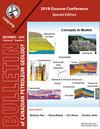基于地层规则的储层建模
Q3 Earth and Planetary Sciences
引用次数: 35
摘要
基于地层规则的建模方法近似沉积动力学,生成储层构型和岩石物性空间分布的数值描述。研究表明,储层模型构建工作流程中包含的一些直观规则可以将储层的非均质性、连续性和空间组织表现为常规储层建模方法难以获得的岩石物性分布。这些规律可以从成熟储层、地表和地下数据集以及基于过程的模型中推断出来。例子包括坐月子、漫步、补偿和治疗规则。通过结合与时间序列中潜在地质过程相关的地层规则,基于规则的建模方法可以比传统的地质统计油藏建模方法更真实地表示推断的储层非均质性。这些方法包括基于变差的方法、基于多点的方法和基于对象的方法,这些方法依赖于一组有限的空间统计数据来描述地质过程的产物。此外,由于这些方法在地质统计学框架内运行,因此可以通过在多种场景和实现中改变有地质意义的参数来探索不确定性,同时保持与输入数据约束的一致性,并在标准工作流程中应用于油藏建模研究。基于规则的建模方法可以实现多种应用,包括:直接用作油藏模型,作为油藏模型输入统计数据(如方差图和训练图像)的来源,以及作为探索数据、模型选择和预测之间关系的数值模拟实验室。挑战仍然存在,如紧急特性的可靠性、与网格框架的一致性以及广泛应用的可行性。尽管存在挑战,但当自然相连续性模式及其相应的岩石物理性质对油藏建模项目的决策支持至关重要时,基于规则的方法可以提供提升。本文章由计算机程序翻译,如有差异,请以英文原文为准。
Stratigraphic Rule-based Reservoir Modeling
Abstract Stratigraphic rule-based modeling methods approximate sedimentary dynamics to generate numerical descriptions of reservoir architecture and the spatial distribution of petrophysical properties. A few intuitive rules included in a reservoir model construction workflow are shown to render realistic reservoir heterogeneity, continuity, and spatial organization to petrophysical property distributions that are difficult to obtain using conventional reservoir modeling methods. These rules may be inferred from mature reservoirs, surface and subsurface datasets, and process-based models. Examples include confinement, meander, compensation, and healing rules. By incorporating stratigraphic rules that relate to the underlying geological processes in temporal sequence, rule-based modeling methods offer more realistic representation of inferred reservoir heterogeneity beyond conventional geostatistical reservoir modeling approaches. These include variogram-based, multiple point-based and object-based approaches that rely on a limited set of spatial statistics to describe the products of geological processes. Moreover, since these methods operate within a geostatistical framework, uncertainty can be explored by varying geologically meaningful parameters over multiple scenarios and realizations whilst maintaining consistency with input data constraints and applied to reservoir modeling studies within standard workflows. Rule-based modeling methods enable a variety of applications, including use: directly as reservoir models, as a source of reservoir model input statistics such as variograms and training images, and as a numerical analog laboratory to explore relationships between data, model choices and forecasts. Challenges remain, such as reliability of emergent features, alignment to grid framework, and feasibility for broad application. Despite challenges, rule-based methods can offer uplift when the natural facies continuity patterns and their corresponding petrophysical properties are critical to support decisions in reservoir modeling projects.
求助全文
通过发布文献求助,成功后即可免费获取论文全文。
去求助
来源期刊

Bullentin of Canadian Petroleum Geology
Earth and Planetary Sciences-Geochemistry and Petrology
CiteScore
2.50
自引率
0.00%
发文量
0
期刊介绍:
The Bulletin of Canadian Petroleum Geology is a peer-reviewed scientific journal published four times a year. Founded in 1953, the BCPG aims to be the journal of record for papers dealing with all aspects of petroleum geology, broadly conceived, with a particularly (though not exclusively) Canadian focus. International submissions are encouraged, especially where a connection can be made to Canadian examples.
 求助内容:
求助内容: 应助结果提醒方式:
应助结果提醒方式:


